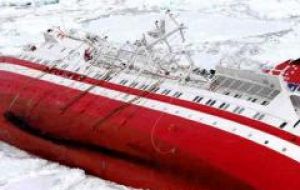MercoPress. South Atlantic News Agency
Floating ice increasing risk for cruise vessels in Antarctica
 Cruise vessel “Explorer” went down in the Bransfield strait
Cruise vessel “Explorer” went down in the Bransfield strait New ice break-offs with dimensions that can’t be properly noticed on the sea surface could become a serious risk for Antarctic cruise vessels in the near future, --even when they are scientifically monitored--, according to Chilean glaciologist Ricardo Jaña from the Chilean Antarctic Institute.
“These pieces of ice float as is we were seeing the roof of a van or truck” and it’s even difficult for the vessels’ radars to detect them. They are identified as “grinders” by the noise they make when they collide with hulls.
Jaña said that the Wilkins shelf has been breaking up since 1998, when it was 20 kilometres wide and 250 metres deep, and again in 2008 when it suffered another collapse.
Although it’s hard predict how the floating ice chunks will evolve or drift, in “two years time they could be heading for the Antarctic Peninsula”, anticipated Jaña.
Sailing in the southern ocean is no longer the same: on November 2007 the cruise vessel “Explorer” went down in the Bransfield strait after running into a block of ice. She was carrying 100 passengers and 54 crew members which were rescued safe and sound.
However visits to Antarctica have soared and now average 40.000 per season.
The Punta Arenas maritime governor, captain Erwin Miranda points out that cruise vessels leaving for Antarctica are expected to have qualified captains with experience in the area as well as bridge officers used to navigate in waters with ice.
However René Preller, an organizer of Antarctic tourist tours from Punta Arenas , with 31 years experience, including in the Arctic, recalls that in 1978 only two cruise vessels with 100 passengers each sailed in the area, and in 2008/09, the number had shot up to 40.000 annual visits.
Sailing at night means using powerful search lights and “running into an iceberg is difficult but colliding with small pieces of ice is far more feasible”, says Preller.
The increase in the number of icebergs and of small pieces of ice in the Antarctic Peninsula could revive the “Titanic factor”, believes Preller. The “Titanic” went down after colliding with an iceberg in North Atlantic, in 1912.




Top Comments
Disclaimer & comment rulesCommenting for this story is now closed.
If you have a Facebook account, become a fan and comment on our Facebook Page!